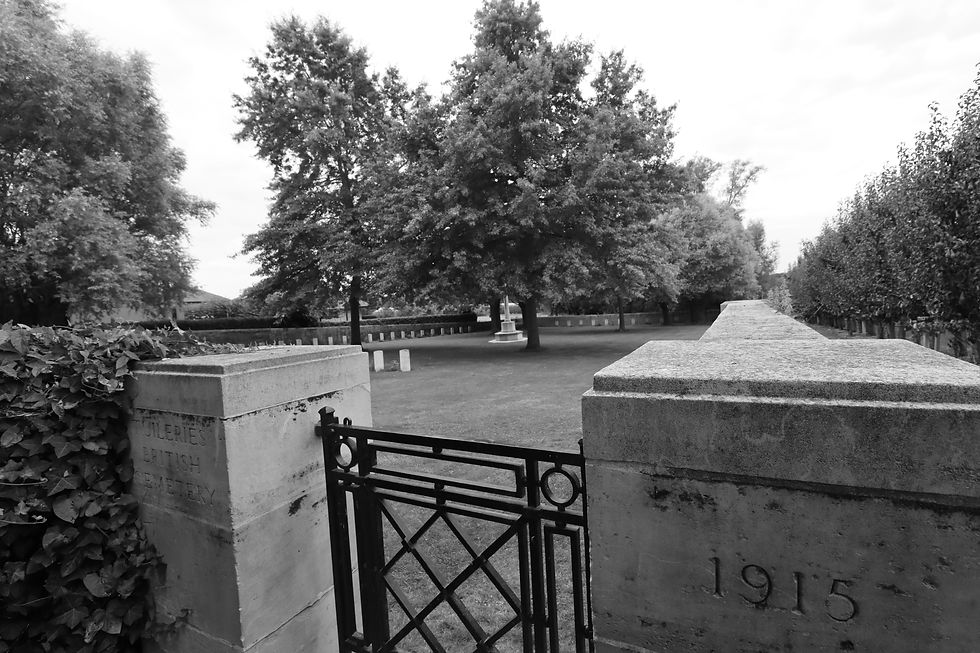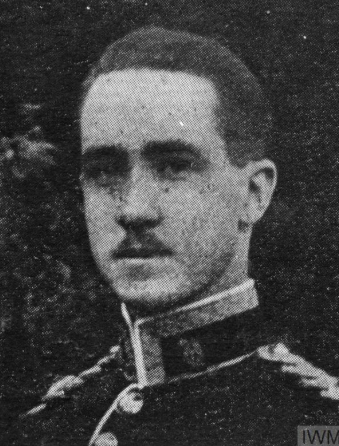Tuileries British Cemetery
- Admin
- Sep 13
- 7 min read

The commune of Zillebeke contains many Commonwealth cemeteries as the front line trenches ran through it during the greater part of the First World War. The Tuileries, or tile-works named Tuileries by the French Corps de Moussy when staying here, was located a little north-west of Zillebeke village, today with the expansion of the village it is within the boundaries, and in 1915, a number of Commonwealth and French soldiers were buried here. The cemetery had some of the earliest British burials, 106 buried here, however, 80 of the 106 graves were destroyed and lost when the cemetery was very badly shelled. Only 10 of the remaining 26 in Rows A to D are identified. On the left as you enter the cemetery is a single French cross to three French men, one unidentified, who are buried here but their remains have been lost. The Cemetery was used between February and May 1915.

Royal Scots Fusiliers
There are four men from the Royal Scots Fusiliers buried here, the grave of one was lost and has a Special Memorial. They were killed during the fighting of March 1915. 7481 Private Hugh Connor, 1st Battalion Royal Scots Fusiliers, 9th Infantry Brigade, 3rd Division. Killed in action 12 March 1915. Grave C.1. His body was exhumed in the cemetery and reburied in the cemetery between 5 to 10 December 1923. His Special Exhumation Report states that he was an Unknown British Soldier and lists other information such as his colour of hair, light brown, any physical peculiarities, his upper jaw was missing and his lower jaw most teeth extracted probably had a plate. On the 12 March 1915, the War Diary records that: ‘A’ Coys trench no’s 43,44,& 45 D sector under 2Lt Prestwood blown up by mine….. The enemy shelled the Salient immediately before and after the explosion but made no attack.’ At 4am on 13 March ‘A’ Company arrived at the Tuileries and remained there for the night. The War Diary records that six men were killed in the period 12 to 13 March, with 35 wounded and 17 missing. 7674 Private Arthur William Whiting, 1st Battalion Royal Scots Fusiliers, 9th Infantry Brigade, 3rd Division. Killed in action 19 March 1915, age 29. Grave D.3. He married Emily on 24 December 1911 and they had two children Emily, born in 1912 aged 2, and Arthur William, born on 12 December 1914, aged 3 months. His pension records show that he died of wounds received however, the War Diary mentions no casualties on 19 March. There are five men wounded on 17 March and two men on 16 March. 6805 Private Alexander Thompson, 1st Battalion Royal Scots Fusiliers, 9th Infantry Brigade, 3rd Division. Killed in action 14 March 1915, age 19. Grave Special Memorial D.6. Son of Mrs. Margaret Thompson, 86 Walton Street, Crumlin Road, Belfast. The War Diary records that for the period of noon on 14 to noon on 15 March ‘1 man killed 3 wounded.’ 12482 Private James Pilmer, 1st Battalion Royal Scots Fusiliers, 9th Infantry Brigade, 3rd Division. Killed in action 20 March 1915. Grave D.4. The War Diary does not record any casualties for 20 March. The Battalion had been relieved by the Lincoln Regiment with ‘C’ and ‘D’ Companies remaining in support.


13874 Private John Mullen, 2nd Battalion Royal Scots, 8th Infantry Brigade, 3rd Division. Killed in action 14 May 1915. Grave Special Memorial D.5. He had a son who was three days old when he was killed. His son was in the care of a guardian Marion McQuade. He landed in France on 21 April 1915. The Battalion was in the line at Hill 60 in trenches 47 to 51 having relieved the Royal Irish Rifles. ‘A’, ‘B’, and ‘C’ Companies occupied the trenches with half of ‘D’ Company in the redoubt and the other half billeted in the Tuileries. The Germans opposite were Saxons and the gap between them was no more than 30 yards. On the 14 May they worked on strengthening their right flank. Casualties recorded were 2 killed and 7 wounded.
Two Officers of the King’s Own (Royal Lancaster Regiment)
Lieutenant Haldane Day Stokes, Member of the Royal Victorian Order. 2nd Battalion King’s Own (Royal Lancaster Regiment), 83rd Infantry Brigade, 28th Division. Killed in action 17 February 1915. Grave D.1. Son of Lieutenant-Colonel Henry Haldane Stokes late RAMC. He was educated at Tonbridge School excelling at sports. He was commissioned from the Militia in July 1907 and served with his Battalion in India promoted to Lieutenant in June 1910. As one of the officers selected to receive the new Colours from King Edward VII he was awarded the M.V.O. 5th Class. The Battalion was in India when war was declared and they arrived on the Western Front in early January 1915. On 17 February ‘B’, ‘D’ and half of ‘C’ Companies were at the Tuileries and ‘A’ Company were in close support in a support trench A2 near Zwarteleen. At 6.30am on 17 February the Germans attacked the section of the line held by the East Yorks and captured the trench. ‘A’ Company was called up to reinforce the East Yorks and attacked the Germans at the point of the bayonet and the lost trench was retaken. The Germans immediately began to shell the trench and Haldane was wounded while assisting his men in repairing the trench. His wounds were dressed and he was taken back to the Aid Post were he died of his wounds.

Lieutenant George Lawrence Harford, Mentioned in Despatches, 2nd Battalion King’s Own (Royal Lancaster Regiment), 83rd Infantry Brigade, 28th Division. Killed in action 17 February 1915, age 23. Grave Special Memorial D.4. He was the eldest son of Canon George and Helen Harford, Rose La, Mossley Hill, Liverpool. He was educated at Marlborough College and went to Sandhurst and was commissioned into the 1st Battalion joining them in India. He transferred to the 2nd Battalion when the 1st Battalion returned to the UK. George was killed in the action above leading his men in the charge to retake the trench.
Captain John Edward Guy Brown, ‘B’ Company, 2nd Battalion attached 1st Battalion Queen’s Own (Royal West Kent Regiment), 13th Infantry Brigade, 5th Division. Killed in action 22 February 1915, age 22. Grave Special Memorial A.2. Son of Alexander Francis Garden Brown and Charlotte Mary Brown, of Strathwell Park, Whitwell, Isle of Wight. He was educated at Bradfield College. He received his commission in the 2nd Battalion, then in India, on 20 September 1911 when aged 19. He successfully passed two examinations in the Indian language in 1913 and won a substantial prize. He was promoted to Lieutenant on 1 July 1914 when home on leave. On the outbreak of war he was attached to the 6th Service Battalion of the Royal West Kent Regiment when it was formed in the new Army. As a result of heavy officer losses he was sent to join the 1st Battalion in October 1914 and saw action throughout November and December. In November, when the Battalion had lost so many officers he was appointed as acting Company Commander during December and January. During his time in the trenches he passed a course under the instruction of the Royal Engineer Officer attached to the Battalion and this qualified him as a Regimental Scout and bomb officer, a post he held at the time of his death. On the 22 February the War Diary records that from 2.15 pm to 4.30pm ‘B’ Company had suffered severely from the enemy bombing and that ‘Lieut Brown, B company, 2nd Lieut Frost A company were killed. Lieut Brown’s body was brought back to some brick works (Tuileries) just north of Zillebeke where the Battalion first aid post was established. Here he was buried with 8 men whose bodies had been recovered. 2nd Lieut Frost’s body could not be found.’
Two Company Sergeant Major’s
There are twenty men from the 2nd Battalion Duke of Wellington’s (West Riding Regiment). 6788 Company Sergeant Major Nelson Farrar, 2nd Battalion Duke of Wellington’s (West Riding Regiment), 13th Infantry Brigade, 5th Division. Killed in action 24 February 1915, age 31. Grave Special Memorial D.10. Son of Tom Harrison Farrar, of Hough Cottage, Halifax, Yorks, and the late Agnes Farrar. He was a regular soldier having enlisted at the age of 18 in 1901. The Battalion was occupying the trenches east of Zillebeke, having relieved the Royal West Kent Regiment. On the 24 February the War Diary recorded that they were in the trenches and had ‘6 killed and 11 wounded.’ 9639 Company Sergeant Major James Alfred Secombe, ‘B’ Company. Killed in action 2 March 1915, Grave Special Memorial C.23. The Battalion marched from Vlamertinghe to relive 83rd Infantry Brigade in the trenches at D sector Zillebeke. On the 2 March the War Diary records that the Germans heavily shelled the trenches 40 to 45 between 8am to 11.30am. They telephoned their artillery which silenced the enemy. ‘B’ Company was in trenches 43,44, and 45 and the War Diary records ‘Sgt Secombe B Coy killed and 3 men wounded by enemy snipers in the morning.’
Location
Tuileries British Cemetery is located 3 Kms east of Ieper town centre, on the Maaldestedestraat, a road leading from the Meenseweg (N8), connecting Ieper to Menen. From Ieper town centre the Meenseweg is located via Torhoutstraat and right onto Basculestraat. Basculestraat ends at a main cross roads, directly over which begins the Meenseweg. 1.5 Kms along the Meenseweg lies the right hand turning onto the Maaldestedestraat. The cemetery itself is located 1.2 Kms along the Maaldestedestraat on the right hand side of the road.

The cemetery was designed by W.C. Von Berg
Burials
The cemetery contains 95 Commonwealth burials and commemorations of the First World War. Only 26 graves (of which 16 are unidentified) are known and marked, and Special Memorials commemorate 69 Commonwealth and two French casualties whose graves in the cemetery were destroyed.
UK – 26
Unidentified – 16
Known Unto God – 11


























Comments